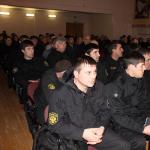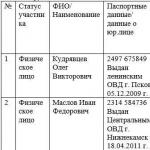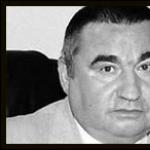Management in diagrams and tables. Modern management (in diagrams): Basic lecture notes. Sladkevich V.P., Chernyavsky A.D.
3rd ed., stereotype. - K.: MAUP, 2003. - 152 p.
The typology and content of modern management are considered; modern approaches to management theory are highlighted; examples of organizational forms of management, strategies of enterprises in market conditions, technologies of modern management are given; problems of power and leadership, transformation of organizational forms of management in the context of the transition to market management methods are shown.
For students of the specialty "Management of Organizations", as well as anyone interested in current issues of modern management.
Format: pdf/zip
Size: 897 KB
/Download file
![]()
Introduction .................................................................................... 3
Topic 1. Introduction to the theory and practice of management............ 5
1.1. Classification (typology) of management.................................................... 5
1.3. Management as a management process.................................................... 8
1.4.Levels of management in the organization.................................................... ..... 9
1.5.Types of management.................................................... ............................ 10
1.6.Approaches to management from a point views of various schools...... 13
1.7.Modern approaches to management.................................................. 16
1.8.Theories and concepts of management................................................. . 18
Topic 2. Organizational forms of management............................ 21
2.1.Stages of creating an enterprise according to the legislation of Ukraine 21
2.2.Designing an organization.................................................... .......... 24
2.3. Creation algorithm organizational form of management... 25
2.4.Characteristics and types of organizations.................................................... 26
2.5.Internal and external factors of the organization (firm) ......... 27
2.6.Types of administrative apparatus.................................................... 28
2.7.Types of organizational powers.................................................... 29
2.8.Types of organizational management structures.................................... 31
2.8.1. Linear management structure.................................................... 32
2.8.2.Functional management structure.............................................. 33
2.8.3. Linear-functional management structure......... 34
2.8.4. Divisional (separate) management structure 36
2.8.4.1. Product management structure.................................... 37
2.8.4.2. Market management structure.................................... 38
2.8.4.3.Regional management structure.................................... 39
2.8.4.4.Global product structure.................................... 39
2.8.4.5.Global regional structure.................................. 40
2.9. Matrix management structure................................................................... ... 41
2.10. Conglomerate (mixed) management structure........... 42
2.11.High structure of the organization.................................................... ..... 43
2.12.Flat structure of the organization.................................................... ..... 45
Topic 3. Enterprise strategies............................. 46
3.1. Main types of firm strategies......................................................... ...... 47
3.1.1.Opportunity strategies by product/market........................... 47
3.1.2. Diversification strategies.................................................. ... 49
3.1.3.Strategies for integration growth.................................................... 50
3.1.4.Product Strategies.................................................... 50
3.1.5. Strategies of small firms............................................... .... 52
3.1.6.Reduction strategies.................................................... ............ 53
Topic 4. Technologies of modern management........................ 54
4.1.Management methods.................................................... ............................... 54
4.2.Control functions.................................................... ........................... 56
4.3.Motivational theories.................................................... .................... 59
4.3.1. Pyramid of needs according to A. Maslow.................................... 61
4.4.Control as a management function.................................................... 63
4.5.Primary information networks.................................................... .64
4.6.Secondary information networks.................................................... .66
4.7.Types of business meetings.................................................... ............... 68
4.7.1. Algorithm for organizing a business meeting
(interpretation by A. Chernyavsky) ............................................. 69
4.8. Management decisions........................................................ ............... 70
4.8.1. Algorithm for making management decisions
(interpretation by A. Chernyavsky) .................................................... 71
4.9. Education mechanism
formal
4.9.1. Pyramid of group motives................................................................... .. 73
4.10. Types of conflicts........................................................ ........................... 75
4.10.1.Algorithm for analysis, evaluation and conflict resolution 77
4.10.2.Ways to manage conflict.................................................... 79
4.11.Factors influencing the development of stress.................................... 82
4.12.Management of the organizational culture of the company.................................... 83
Topic 5. Power and leadership in the activities of managers........... 85
5.1.Sources of power for managers.................................................... ......... 85
5.2.Basic approaches to the problem of leadership.................................. 87
5.2.1. Basic theories of leadership behavior................................... 89
5.2.1.1.Three leadership styles according to K. Lewin.................................... 90
5.2.1.2.Leadership styles research results Ohio State University (USA) 91
5.2.1.3.“Management Grid” (developed by American scientists R. Blake and J. Mouton in the 80s of the twentieth century). 92
5.2.1.4.“Barometer management” (developed by A. Chernyavsky in 1991) 93
5.2.1.5.Four leadership systems according to R. Likert...... 95
5.2.1.6.Four types of leadership according to the concept of reward and punishment 96
Topic 6. Transformation methods organizational forms
management in transition ............................................. 97
6.1.Method of disintegration when transformation of the organizational form of management 98
6.2.Integration method.................................................... ........................... 103
Topic 7. Organization management methods.................................. 106
Topic 8. Methods for finding new ideas and solutions........................... 113
8.1. Brainstorming and its varieties.................................................... 113
8.1.1.Classic brainstorming.................................................... 113
8.1.2.Anonymous brainstorming.................................................... .. 117
8.1.3.Destructive-constructive brainstorming........... 119
8.2. Conference of ideas................................................... ........................... 121
8.2.1. Conference of Gilde's ideas............................................................ .... 121
8.2.2.Method 635 ................................................. ................................... 123
8.3. Synectics........................................................ ........................................... 125
8.3.1.Classical synectics.................................................. ........ 125
8.3.2. Synectic conference.................................................... 127
8.3.3.Visual synectics.................................................. ............ 127
8.4.Brain recording pool.................................................... ........................... 127
8.5.The Delphi idea.................................................... ........................................ 129
8.6.Survey using cards.................................................... ............... 131
8.7.Ideological engineering.................................................... ........................... 131
8.8.Collective notepad method.................................................... ........ 133
8.9.Trigger technique.................................................... ........................... 133
8.9.1.Focal object method.................................................... ... 134
8.9.2.Method of garlands of accidents and associations.................................. 134
8.10.Analysis of an annoying word.................................................... ......... 135
8.11.Method “TILMAG” .................................................... ................................ 135
8.12. Test question method.................................................... .......... 135
8.13.Method of morphological analysis.................................................. .136
Topic 9. Improvement management methods....................... 138
9.1. Main reasons for lack of time.................................................... 138
9.2.Analysis of the use of working time.................................... 139
9.3. Main ways to improve the management system.... 140
9.4.Planning the manager’s working time.................................... 142
9.5.Methods for organizing working time plans.................................. 144
9.6.Operational planning of performers’ activities.. 146
List
Typology and levels of management in an organization: creation of organizational structures, types of management strategies and technologies (diversification, reduction, integration), systems of leadership power, search for promising solutions in the transformation of management forms.
Send your good work in the knowledge base is simple. Use the form below
Students, graduate students, young scientists who use the knowledge base in their studies and work will be very grateful to you.
There is no HTML version of the work yet.
You can download the archive of the work by clicking on the link below.
Similar documents
Theoretical foundations of management and its development at the present stage. Management theories. The role of management in enterprise management. Types of organizational structures for managing an organization. Features of the formation of modern management in Ukraine.
course work, added 11/24/2010
The meaning and functions of management typology. Types of management. Selecting alternatives for effective management. Diversification of management. Planned-directive, targeted, regulatory, normative, highly centralized and socially regulated management.
abstract, added 02/03/2009
Study of the effectiveness of the management system of OJSC "Altai Tire Plant". The essence of management: information, organization and management process. Types of organizational structures: linear, functional, linear-functional, divisional, adaptive.
course work, added 05/27/2014
Types of organizational structures of management. Analysis of factors influencing the organizational structure of an enterprise. The principle of compliance of the powers and responsibilities of management employees with their place in the hierarchy. Forms of communication in organic management structures.
abstract, added 11/09/2013
Organization of a project management system at an enterprise in modern economic conditions. Construction of organizational structures for project management of organizations. Identification of problems in project management of OJSC Saturn and search for ways to improve.
thesis, added 08/23/2011
The essence and content of management, its goals and objectives. Relationship between management and other sciences. The current stage of development of the Russian economy and improvement of management. Types of enterprise management structures. Content theories of motivation, types of conflicts.
cheat sheet, added 04/22/2010
Management as the science of managing people. Levels of personnel management and main types of organizational structures. Fundamentals of personnel management and personal contribution of the manager. Methods of personnel assessment and hiring. Improvement of personnel qualifications.
course work, added 10/10/2008
Section 1. BASIC INFORMATION ABOUT MANAGEMENT (1) Management is ordered actions aimed at achieving set goals in accordance with available resources. From this definition it follows that management takes place only when the following are defined: 1. Goals that need to be achieved, i.e. The basis of any management is certainly goal setting. 2. Ordered actions to achieve these goals: physical (mechanical, light, electromagnetic, etc.), chemical, energy, information, etc. 3. Resource – a source or supply of something that can be accessed (temporary, material or energy, financial, personnel, etc.). The management process is a set of mutually nested co-occurring events.
Section 1. BASIC INFORMATION ABOUT MANAGEMENT (2) System – A system is a set of interacting elements that implement the target function. In this case, objects (parts) function in time as a single whole; each object, subsystem, cell works for a single goal facing the system as a whole. Element - An element is an indecomposable component of a system in a given way of considering it. Subject of management The subject of management personifies an actively acting, conscious individual or social group that forms the target function and carries out management. Control object The control object is an organized part of the environment towards which the activity of the control subject is directed. The issuance and receipt of influence from the control object and the environment to the control subject are feedback connections. Issuing and receiving information from the control subject to the control object and the environment are direct connections.
Section 1. BASIC INFORMATION ABOUT MANAGEMENT (3) Structure is, first of all, the natural connections of elements in the system, and among the latter, the most significant are integrating connections. Connections are what connect objects and properties in the management process into a single whole. It is assumed that connections exist between all system elements, between systems and subsystems. Connections can be classified: According to the form of determinism: unambiguous, otherwise determined; unambiguous, otherwise deterministic; probabilistic, otherwise stochastic; probabilistic, otherwise stochastic; By strength: hard, weak, strong, By direction of action: direct, reverse. direct, reverse. According to their significance: insignificant, significant. insignificant, significant.
Section 1. BASIC INFORMATION ABOUT MANAGEMENT (4) Modeling. Model – A model is a logical diagram that simplifies reasoning and logical construction or allows experiments to be carried out that clarify the nature of phenomena. Model – A model is the replacement of one object with another in order to obtain information about the most important properties of the original object.
Section 1. CONTROL BASICS (5) Control and display. The concept of “system boundaries” prescribes a limit within which objects, properties and their connections can be adequately explained and managed. In the absence of a localized managing subject, control represents an information exchange between a control object located in a certain environment and a managing subject, i.e. circulation of information along closed circuits in a self-governing system in the process of its exchange with the environment. The subject of management and the object of management are distinguished from the environment according to stereotypes of discrimination and transformation of information.

Section 1. BASIC INFORMATION ABOUT MANAGEMENT (7) System management. input quantities External influences that, under the conditions of the problem being solved, significantly affect the state of the system are called input quantities (input influences, input variables of the system), and the elements of the system to which input influences are applied are called system inputs. output quantities The impact of a system on the environment is characterized by the values of its output quantities. The set of output values and their changes determine the behavior of the system and allow the manager to assess the compliance of the system’s movement with management goals. To solve control problems (Fig. 1.8), two types of input quantities and output quantities are distinguished: control actions X; disturbing influences M output quantities Y. Control quantities include those quantities whose values can be controlled when controlling the system and which can be changed in order to carry out a movement that is preferable compared to other possible movements of the controlled system.

Section 1. BASIC CONTROL INFORMATION (8) Description of the system state. state vector of systems The state of any system with a given accuracy can be characterized by a set of values of quantities m that determine its behavior, i.e. vector of systems state. One of the forms of describing the state of a system is the state space of the system. region of admissible states The region of state space in which the representing point is located is called the region of admissible states. Management is the process of dynamic simulation modeling by the subject of management of the transfer of a system from one state that is stable according to acceptable parameters to another, taking into account the factors influencing the processes of activity, the structure of external and internal connections and the ability to ensure the management itself.

Section 1. BASIC INFORMATION ABOUT MANAGEMENT (9) Interconnection of management systems and processes. Fig. Interdependence of control systems. Any system can be divided into subsystems. Objects belonging to one system can be considered as parts of the environment or elements of another subsystem. Subsystem analysis requires the study of a new set of relationships. If possible, the system should be divided into subsystems. The elements of the system themselves can be systems of lower orders. The concept of a subsystem is used to analyze complex, self-developing systems, in which intermediate “steps” can be distinguished between the elements and the system as a whole, more complex in some sense than the elements and less complex than the system.
 Section 1. BASIC INFORMATION ABOUT MANAGEMENT (10) Management conditions. Control, in principle, is possible only when the laws of existence of an object (process) in the environment are known. Therefore, any control is a private process in the Universe, which allows you to bring a process occurring objectively to a subjectively chosen flow regime from a variety of objectively possible options for the development of the process. This is the main content of the concept of management. It is impossible in principle to control subjective processes.
Section 1. BASIC INFORMATION ABOUT MANAGEMENT (10) Management conditions. Control, in principle, is possible only when the laws of existence of an object (process) in the environment are known. Therefore, any control is a private process in the Universe, which allows you to bring a process occurring objectively to a subjectively chosen flow regime from a variety of objectively possible options for the development of the process. This is the main content of the concept of management. It is impossible in principle to control subjective processes.

Book author:
Chapter: ,
Book language:Publisher:
The year of publishing:
ISBN: 9785392027446
Size: 9 MB
Attention! You are downloading an excerpt of a book permitted by law and the copyright holder (no more than 20% of the text).
After reading the excerpt, you will be asked to go to the copyright holder’s website and purchase the full version of the work.
Business book description:
The textbook is written in accordance with traditions that require that the material presented be logical, systematized, meaningful, and make it as easy as possible for students to study the course. Schemes and definitions represent a brief theoretical summary of the material, as well as practical characteristics of management. The manual will be indispensable both when preparing for the exam as a systematizing source, and during the initial introduction to the discipline. For students of higher educational institutions, graduate students, teachers, practitioners, as well as everyone interested in management issues.
Copyright holders!
The presented fragment of the book is posted in agreement with the distributor of legal content, LitRes LLC (no more than 20% of the original text). If you believe that the posting of material violates your or someone else's rights, then.





